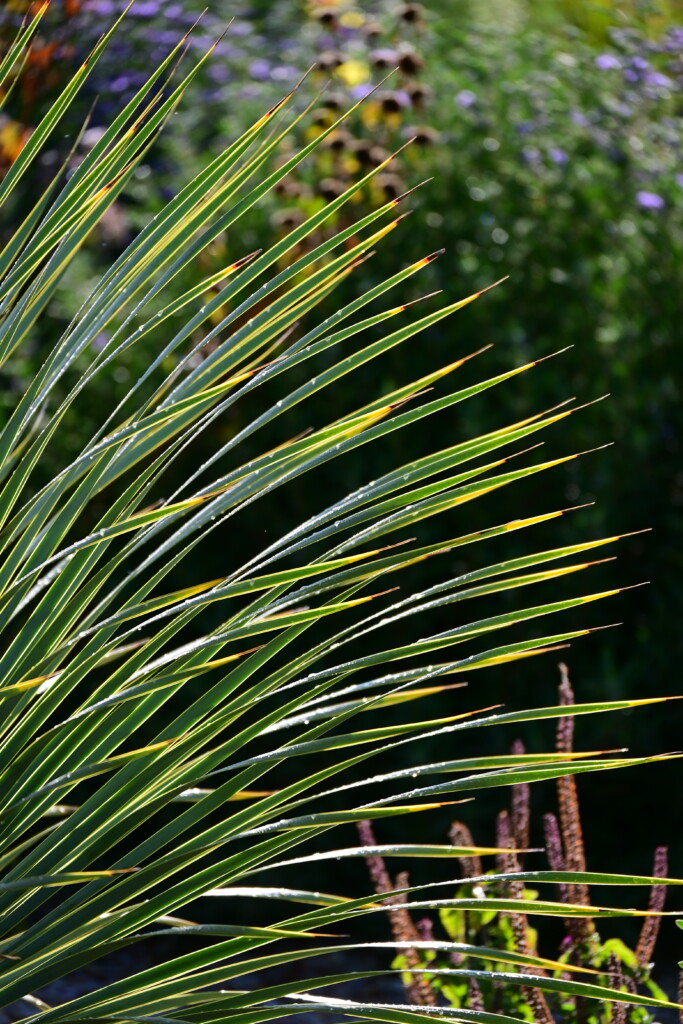I vividly recall nearing the end of a slow, slow walk though the sun-bleached grounds of the Villa San Giuliano in Sicily, and stepping into the dim, sepulchral light of the family chapel. For many years used for farm storage, the recently re-frescoed walls slowly emerged as our eyes adjusted. Then we swung around to exit, and across the lawn, framed perfectly by the arched chapel doorway, was a stand of Yucca rostrata of such dramatic, metallic form, so brilliantly and blindingly lit by the sun, that it felt like you were peering into another reality entirely – looking through a window from one whole world into another.

A year or two before then, a client had bought three young seedlings, and asked me to place them in amongst their perennial garden. I thought it a slightly odd mix, but am always up for a visual experiment like this. As it has turned out, it IS a slightly odd mix, but these plants have become key visual anchors in almost every pic I’ve taken of this perennial garden since. That there is more than one is critical. It’s possible to validate all sorts of odd choices by repetition. And I’m not looking for a pinpoint focus in this kind of planting, as much as a focal ‘zone’.

Clearly capable of surviving the kind of frost that cuts down but doesn’t kill the Mexican salvias, the one thing these fabulous yuccas would not cope with is standing in water. Other than that, their needs are few. After about eight years, the apices of my client’s plants are about chest high. The primary rosette will eventually flower and die, hopefully producing both pups beforehand and seed after, but the longer we can put off that moment, the better.

Hi Michael,
In my Lauriston, extremely frosty garden, I planted three Yukka whipplei “blue as blue’ , which is the same, I think, as rostrata, about six years ago. Last season 2 flowered magnificently and I was told would then die. They have not. They have now started multi-trunking after cutting off the flower stalks. I found just one seed!
This season, the third yukka flowered and again, set just one seed.
They thrive with zilch care in horrid sub-soil clay as the garden is on old gold mining territory. Extremely happy with them as they are survivors out here where as my seven beautiful big Furcraeas all died after a very frosty winter!
Margot
Thanks for this info, Margot. I must look out for this form. Sounds fabulous. And so good that it works on clayey subsoil. Imagine what all those gold mining areas must have looked like, immediately after the gold rush finished! If there was any topsoil left it would have been feet underground. I always have that sense of soil-trauma when driving to Castlemaine – those few last kms coming through Chewton. 150 years later, it still looks recently disturbed.
Hi Michael,
Absolutely love the way you have integrated this yukka – it adds a terrific buzz ! And I’m all for including personal memories, and their stories, amongst the sustainability we are all thinking about.
The conference this year was a particular thrill ….. I happened to overhear your reaction to a delegate’s complimenting of your ‘Plant of the Week’ blog. I would like to reiterate the pleasure this and your writing brings, even if it becomes ‘Plant of the Month’ …..
With thanks.
Jennifer
Thanks so much for this, Jennifer. I really appreciate your comments about Plant of the Week. I’ll see if I’ve got the stamina to stick with it. It’s just not my favourite way to write – I’d be much happier talking about planting ie plant combinations, than about particular plants, but we’ve started it now, and apparently there’s a reasonably high level of addiction…